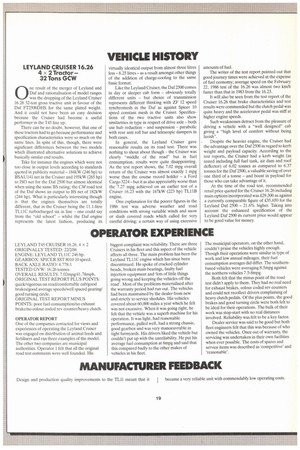VEHICLE HISTORY
Page 179

If you've noticed an error in this article please click here to report it so we can fix it.
LEYLAND CRUISER 16.26 4 x 2 Tractor — 32 Tons GCW
0 nc result of the merger of Leyland and Daf and rationalisation of model ranges was the dropping of the Leyland Cruiser 16.26 32-ton gross tractive unit in favour of the Daf FT2500DHS for the same plated weight. And it could not have been an easy decision because the Cruiser had become a useful performer in the T45 line up.
There can be no doubt, however, that one of these tractors had to go because performance and specification characteristics were so much on the same lines. In spite of this, though, there were significant differences between the two models which illustrated alternative solutions to achieve basically similar end results.
Take for instance the engines which were not too close in output levels according to standards quoted in publicity material 184kW (246 hp) to BSAU141 net in the Cruiser and 195kW (265 hp) to ISO net for the Daf 2500 but almost identical when using the same BS rating: the CM road test of the Daf shows an output to BS net of 182kW (244 hp). What is particularly interesting though is that the engines themselves are totally different, that in the Cruiser being the 11.1-litre 11,11C turbocharged six in line one could say from the "old school" whilst the Daf engine represents the latest fashion, producing its virtually identical output from almost three litres less -8.25 litres as a result amongst other things of the addition of charge-cooling to the same basic format.
Like the Leyland Cruiser, the Daf 2500 comes in day or sleeper cab form obviously totally different units but choice of transmission represents different thinking with ZF 12 speed synchromesh in the Daf as against Spicer 10 speed constant mesh in the Cruiser. Specifications of the two tractive units also show similarities in type in respect of drive axle both use hub reduction and suspension parabolic with rear anti roll bar and telescopic dampers in both cases.
In general, the Leyland Cruiser gave reasonable results on its road test. There was nothing to shout about though the Cruiser was clearly "middle of the road" but in fuel consumption, results were quite disappointing. As the test report shows, the 7.02 mpg overall return of the Cruiser was almost exactly 1 mpg worse than the course record holder a Ford Cargo 3224but it as also appreciably worse than the 7.27 mpg achieved on an earlier test of a Cruiser 16.23 with the 167IcW (223 hp) TL11B engine.
One explanation for the poorer figures in the 1986 test was adverse weather and road conditions with strong variable winds and snow or slush covered roads which called for very careful driving; a certain way of using excessive amounts of fuel.
The writer of the test report pointed out that good journey times were achieved at the expense of fuel economy; average speed on the February 22, 1986 test of the 16.26 was almost two km/h faster than that in 1983 from the 16.23.
It will also be seen from the test report of the Cruiser 16.26 that brake characteristics and test results were commended but the clutch pedal was quite heavy and the accelerator pedal was stiff at higher engine speeds.
Such weaknesses detract from the pleasure of driving a vehicle with a "well designed" cab giving a "high level of comfort without being lavish".
. Despite the heavier engine, the Cruiser had the advantage over the Daf 2500 in regard to kerb weight and payload capacity. According to the test reports, the Cruiser had a kerb weight (as tested including full fuel tank, air dam and roof deflector) of 6.02 tonnes as compared to 6.37 tonnes for the Daf 2500, a valuable saving of over one third of a tonne and boost in payload for ' those who can take advantage of it.
At the time of the road test, recommended retail price quoted for the Cruiser 16.26 including main options incorporated was £29,300 as against a currently comparable figure of £35,650 for the Leyland Daf 2500 21.6% higher. Taking into account the enhanced specification of the Leyland Daf 2500 its current price would appear to be good value for money.
































































































































































































